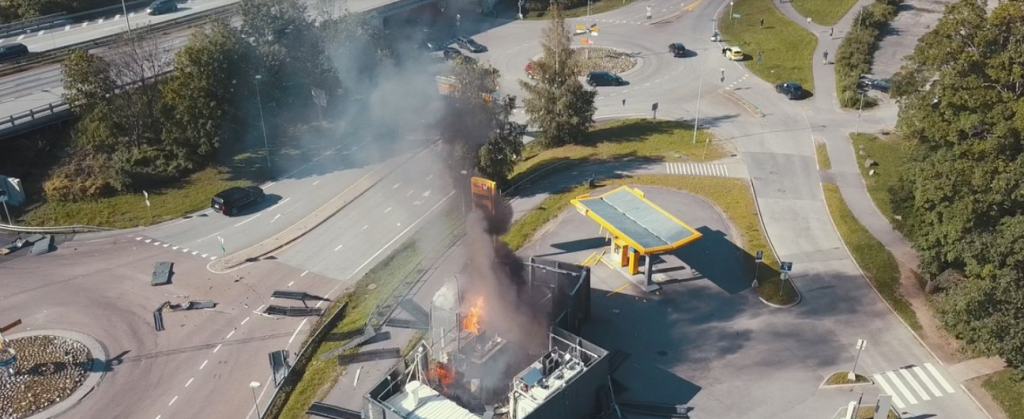
An explosion, most likely in a single hydrogen tank, occurred at the Uno-X hydrogen station at Sandvika, near Oslo, on 2019-06-10. When writing this post, the cause of the explosion was not known.
While no one appears to have been directly injured in the explosion, two people driving in the vicinity were injured when their airbags activated because of air pressure from the explosion.
The explosion resulted in the closing, in both directions, of two major highways. European Highway 16 (E16) is the major east-west connection between Bergen and the Swedish border. The E18 connects southern Norway with Oslo.
For those interested in robotics, a LUF 60 wireless remote controlled mobile firefighting support machine, was actively used to suppress the fire that followed after the explosion. More importantly, it was used to cool other unexploded hydrogen tanks, to prevent them from exploding. In addition, a platform lift with water canon assisted with this task. These two vehicles allowed firefighters to keep their distance.
Norway’s other two hydrogen stations, one in Skedsmo, another Oslo suburb, and the other in Bergen, have now been closed.
According to Norwegian Hydrogen Forum as of 2018-12-31 there were 148 hydrogen cars registered in Norway: 57 Toyota Mirais, 27 Hyundai Nexos, and 64 Hyundai iX35s. In addition to this there are 5 buses and 1 truck. In contrast, as of the same date there were 200 192 plug in electric vehicles, plus 96 022 hybrid vehicles.
In another post titled Methane vs Electricity, a significantly flawed study from the Munich-based IFO Institute for Economic Research, was examined, along with its support for methane based, hydrogen vehicles.
With this explosion, hydrogen supporters in Norway will have lost much of the little good will that hydrogen fuel cells have built up. It has probably resulted in the last nail being put into the hydrogen car coffin.


Another hydrogen explosion this month: 2019-06-01. An explosion and fire at a chemical, gas storage and transportation facility in Santa Clara, California, on Saturday afternoon was extinguished by evening and no injuries were reported, according to fire officials.
Santa Clara Fire Department responded and found multiple hydrogen tanker trucks on fire in the facility yard. The explosion occurred after a hydrogen tank being fueled started to leak.
Nel, the manufacturer of the hydrogen dispensing technology, has now closed 10 hydrogen stations, including those in Denmark and other European countries. The station that exploded in Norway, was the first station of its kind when it opened in November 2016.
The components consist of patented technology solutions that include more powerful compressors and cooling plants than what existed in the market before 2016.
Improved cooling meant that the dispenser (“pump”) could be placed up to 50 meters from the other components. The dispenser takes about one third of the space of an ordinary gasoline pump.
Previous dispensers placed all components in the same box, including hydrogen storage tanks on the roof. At the Uno-X station that exploded, the storage tanks are separated from the compressor module. The entire station has a footprint of 10 m2, compared to 30 m2 for the previous generation.
Toyota and Hyundai have both stopped the sale of their hydrogen cars in Norway, at least temporarily. This applies to the only two models currently being sold, the Toyota Marais (27 sold in 2018, 7 sold so far in 2019) and the Hyundai Nexos (27 sold in 2018, an unknown number sold in 2019).
Below is a link to a report titled, Production and Use of Hydrogen in Norway, commissioned by the Climate and Environmental Department and by the Oil and Energy Department of the Norwegian government, and prepared by DNV GL Energy Markets and Technology (previously Den norske Veritas). Sections 1.3 Summary (on page 9) and 1.4 Key Findings (pages 10 to 15) are written in English.
https://www.regjeringen.no/contentassets/0762c0682ad04e6abd66a9555e7468df/hydrogen-i-norge—synteserapport.pdf
DNV GL believes that both electric cars and hydrogen cars will be cheaper to own than fossil cars by 2025, but that hydrogen cars will be more expensive if one sees the purchase price and operating costs together.
Here is a comment I received from Brad Laesser in an email:
Hello Brock,
I do have just simple explanation regarding Industrial gases. I have combusted various gases fuels and have kept this simple safety rule, ” the lower the BTU or Caloric value of a gas is, the more dangerous the gas is. Off the top of my head, Blast furnace gas is approximately 90 too 100 Btu/cu ft. and when mixed with air within a confined space, the percentage of air is approximately 12%. In other words, detonation doesn’t require an open flame or a match….. Likewise, Coke Oven gas mixture (480 to 560 btu/cu ft.) approximately 16%. Natural gas, 990 to 1000 Btu: approx 36%……Hydrogen has a btu value of 62000 per cu ft and the air percentage is 5% to 70%. My bet is the cylinder that is the culprit most probably had a leak. Oh! Did I tell you the explosions involving the lower btu gases are far more sever in the outcome. Incidentally, I worked as an Engineer in a Metalurgical Coke Plant, producing millions of Coke Oven gas each day.